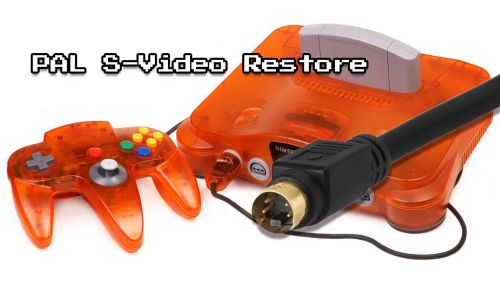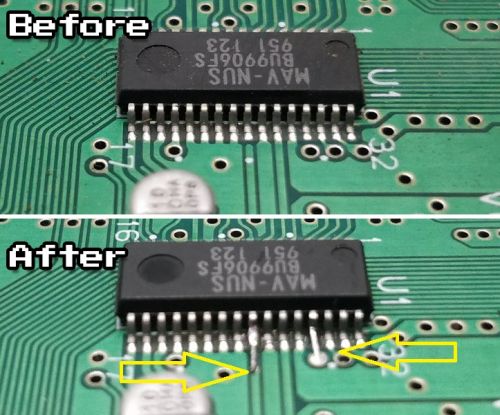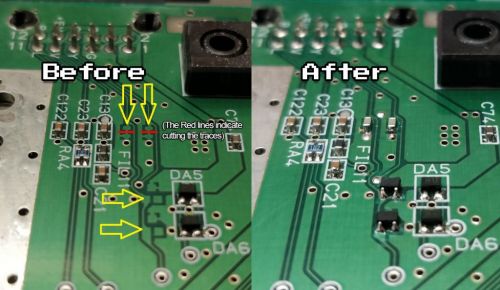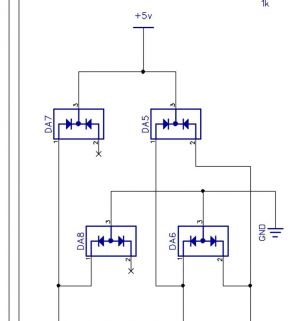N64:PAL Funtastic Model S-Video Restore Mod: Difference between revisions
m (Derf moved page N64:PAL Funtastic Model S-Video Restore Mod to N64:PAL Funtastic Model S-Video Restore Mod) |
m (insert picture test, wrap & frameless) |
||
| Line 1: | Line 1: | ||
[[File:PALN64S-VideoRestore0-1536x864.jpg|frameless|500x500px]] | |||
Jan from Consoles4U has developed a fix for the few PAL N64’s that don’t output S-Video. | Jan from Consoles4U has developed a fix for the few PAL N64’s that don’t output S-Video. | ||
| Line 22: | Line 22: | ||
I have no idea why this wasn’t just done from the factory. It almost looks like more work not to connect them!: | I have no idea why this wasn’t just done from the factory. It almost looks like more work not to connect them!: | ||
[[File:PALN64S-VideoRestore1.jpg|frameless|500x500px]] | |||
'''Restore the missing components near the multi-out:''' | '''Restore the missing components near the multi-out:''' | ||
| Line 33: | Line 34: | ||
Below that, DA7 and DA8 appear to be two ESD diodes with different polarity. | Below that, DA7 and DA8 appear to be two ESD diodes with different polarity. | ||
[[File:PALN64S-VideoRestore2-1024x594.jpg|frameless|500x500px]] | |||
We are researching the possibilities of having a board that drops over the multi-out pins and connects Y&C from the two via’s on the motherboard. This would eliminate any need for mask shaving and component replacement on the rear side of the motherboard. You’d still need to re-connect the traces on the chip as shown above though. | We are researching the possibilities of having a board that drops over the multi-out pins and connects Y&C from the two via’s on the motherboard. This would eliminate any need for mask shaving and component replacement on the rear side of the motherboard. You’d still need to re-connect the traces on the chip as shown above though. | ||
[[File:PALN64S-VideoRestore3-768x821.jpg|frameless]] | |||
Fidde_se made some research into the components based on Jans previous work so that we no longer needed to transfer components from other N64 boards and found the correct ones. | Fidde_se made some research into the components based on Jans previous work so that we no longer needed to transfer components from other N64 boards and found the correct ones. | ||
Revision as of 14:44, 3 January 2023
Jan from Consoles4U has developed a fix for the few PAL N64’s that don’t output S-Video.
This one far easier than the “advanced” RGB mod’s that would be required on the incompatible revisions. Here’s more info:
The Nintendo 64’s video output is an unfortunately confusing discussion, that includes both region and motherboard revision issues. Here’s an easy breakdown of all the video-out options from the N64: All N64’s support composite video out using the same cable and luckily, the composite signal from an N64 is very good.
Next, all N64’s can be modded for RGB, but unless you have an (easily identifiable) early NTSC revision, it’s a complicated mod. Here’s more info on how to find which model you have and the options available: https://www.retrorgb.com/n64rgbcompatible.html
Finally, all NTSC and most PAL N64’s can output S-Video without a mod, but you’ll need a different cable for PAL than NTSC. Also, figuring out which PAL models don’t support S-Video can be confusing. At the moment, it’s believed that the NUS-CPU-P-03 (Pikachu and Funtastic) and the NUS-CPU-R-01 (French release) are the only ones that don’t support S-Video from the factory, but you’ll need to connect your cable to be sure.
So, what happens if you connect a proper S-Video cable to a PAL N64 and don’t get a signal? Well, the incompatible PAL models would all require the much more complicated RGB mod, but that’s a possibility. Another option would be to restore the N64’s S-Video circuit to the multi-out.
Jan from Consoles4You has been researching exactly what’s required to accomplish an S-Video restore and has made some good progress. There seems to be two steps required: Re-connect the luma and chroma traces from the chip:
Re-connect the luma and chroma traces from the chip:
The Y&C pins from the MAV-NUS chip are just floating and not connected to the traces that are right in front of them! To restore, you’ll need to first scrape off a tiny bit of the motherboard layer in front of pin 25, then solder a jump between that pin and the trace. Then connect pin 29 on the chip to the via directly above it.
I have no idea why this wasn’t just done from the factory. It almost looks like more work not to connect them!:
Restore the missing components near the multi-out:
Now you’ll have to re-populate the four missing components near the multi-out. In order to solder them, you’ll need to carefully scrape off the mask over the pads and solder them in place.
On top are two 47pF SMD capacitors. You’ll need to cut the traces between them, then scrape the green mask over the mounting squares.
Below that, DA7 and DA8 appear to be two ESD diodes with different polarity.
We are researching the possibilities of having a board that drops over the multi-out pins and connects Y&C from the two via’s on the motherboard. This would eliminate any need for mask shaving and component replacement on the rear side of the motherboard. You’d still need to re-connect the traces on the chip as shown above though.
Fidde_se made some research into the components based on Jans previous work so that we no longer needed to transfer components from other N64 boards and found the correct ones.
DA5 (Marking: MU)
DA6 (Marking: MO)
DA7 (Marking: MU)
DA8 (Marking: MO)
M1MA142WK (Marking: MU) DigiKey Link
M1MA142WA (Marking: MO) DigiKey Link
DA=Diode Array
Package: SOT-323
Most ESD diodes or TVS are zeners, one in both directions but these are used in a different way, which can be seen on the links below.
Altium's Beginners guide ESD to protection in circuit design pcbs
Electronic-Notes ESD circuit design guidelines



